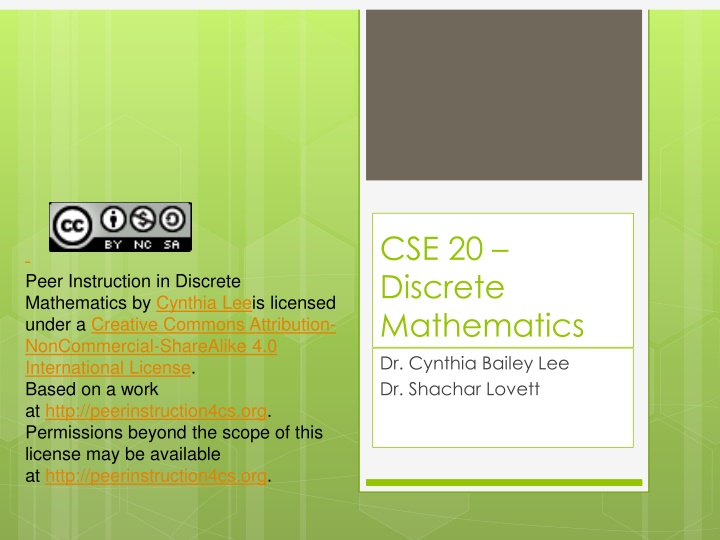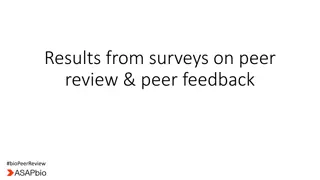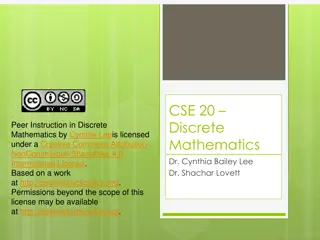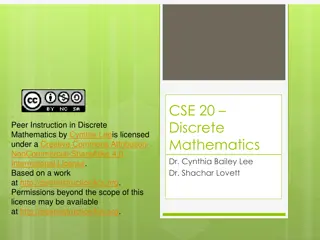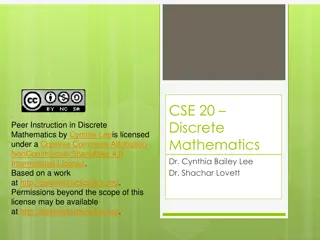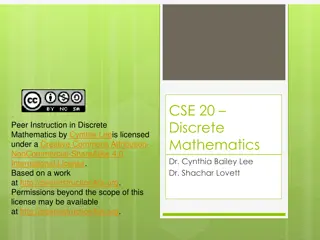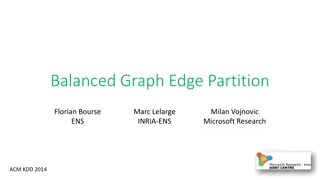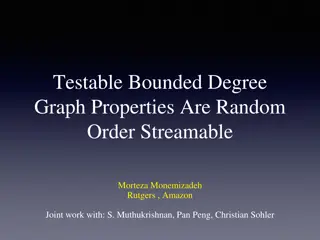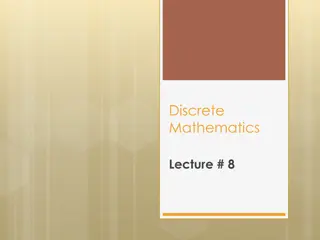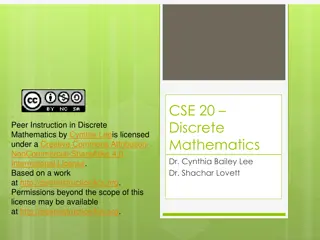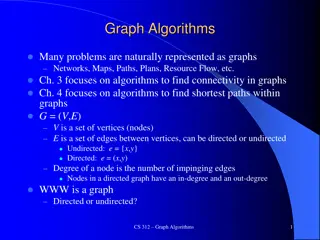Peer Instruction in Discrete Mathematics: Graph Algorithms
concept of graph algorithms in discrete mathematics through peer instruction. Understand the reachability of vertices in graphs using induction and algorithmic reasoning. Discover practical applications and intuitive approaches to solve reachability problems.
Uploaded on Feb 24, 2025 | 1 Views
Download Presentation

Please find below an Image/Link to download the presentation.
The content on the website is provided AS IS for your information and personal use only. It may not be sold, licensed, or shared on other websites without obtaining consent from the author.If you encounter any issues during the download, it is possible that the publisher has removed the file from their server.
You are allowed to download the files provided on this website for personal or commercial use, subject to the condition that they are used lawfully. All files are the property of their respective owners.
The content on the website is provided AS IS for your information and personal use only. It may not be sold, licensed, or shared on other websites without obtaining consent from the author.
E N D
Presentation Transcript
Creative Commons License CSE 20 Discrete Mathematics Dr. Cynthia Bailey Lee Dr. Shachar Lovett Peer Instruction in Discrete Mathematics by Cynthia Leeis licensed under a Creative Commons Attribution- NonCommercial-ShareAlike 4.0 International License. Based on a work at http://peerinstruction4cs.org. Permissions beyond the scope of this license may be available at http://peerinstruction4cs.org.
2 Today s Topics: 1. Graph algorithm: Reachability
3 Algorithms We will see today how to use induction to argue about algorithms This is mainly what you will be using it for, both in class and later in your jobs We focus here on graph algorithms, but similar ideas apply to many other domains: chip optimization problems, bio-informatics, routing internet traffic, etc.
4 What is an algorithm? An algorithm is an efficient way to process information It has inputs It needs to produce an output
5 Reachability Input: undirected graph G two designated vertices: s (source) and t (target) Output: is there a path in G from s to t
6 Reachability Example: is t reachable from s? I s A. Yes B. No t
7 Reachability Example: is t reachable from s? I s A. Yes B. No t
8 Reachability Potential application: sidewalk reachability G sidewalk graph Source: s = CSE building Target: t = Sea world Can I safely walk from the CSE building to Sea world?
9 Algorithm Intuition Intuition: gradually discover all vertices reachable from s Each vertex v has a label L(v) L(v)=yes means it is reachable from s L(v)=? means we don t know yet At the end, we found all vertices reachable from s if L(v)=? then it is not reachable from s Return yes if L(t)=yes; no otherwise
10 Algorithm Intuition Recall: in an undirected graph G, the neighbors of a vertex v are all vertices u where u,v is an edge Boundary = set of vertices whose neighbors were not explored yet
11 Reachability Algorithm Input: undirected graph G, vertices s,t Output: is there a path in G from s to t 1. Initialize labels: L(s)=yes; L(v)=? for all v s 2. Initialize boundary: B={s} 3. While B is not empty: 3.1 Choose a vertex v B 3.2 Remove v from B 3.3 For all neighbors u of v in G: 3.3.1 If L(u)=? then: set L(u)=yes and add u to B 4. If L(t)=yes return yes; otherwise return no
12 Running example Input: undirected graph G, vertices s,t Output: is there a path in G from s to t s Y 1. Initialize labels: L(s)=yes; L(v)=? for all v s 2. Initialize boundary: B={s} 3. While B is not empty: 3.1 Choose a vertex v B 3.2 Remove v from B 3.3 For all neighbors u of v in G: 3.3.1 If L(u)=? then: set L(u)=yes and add u to B 4. If L(t)=yes return yes; otherwise return no a d t ? ? ? ? ? c b Initializing labels B={s}
13 Running example Input: undirected graph G, vertices s,t Output: is there a path in G from s to t s Y 1. Initialize labels: L(s)=yes; L(v)=? for all v s 2. Initialize boundary: B={s} 3. While B is not empty: 3.1 Choose a vertex v B 3.2 Remove v from B 3.3 For all neighbors u of v in G: 3.3.1 If L(u)=? then: set L(u)=yes and add u to B 4. If L(t)=yes return yes; otherwise return no a d t Y ? ? ? ? c b Loop beginning: B={s} Choose v=s in step 3.1 Neighbors = {a} Neighbors labeled with ? = {a} Loop end: B={a}
14 Running example Input: undirected graph G, vertices s,t Output: is there a path in G from s to t s Y 1. Initialize labels: L(s)=yes; L(v)=? for all v s 2. Initialize boundary: B={s} 3. While B is not empty: 3.1 Choose a vertex v B 3.2 Remove v from B 3.3 For all neighbors u of v in G: 3.3.1 If L(u)=? then: set L(u)=yes and add u to B 4. If L(t)=yes return yes; otherwise return no a d t Y ? Y Y Y c b Loop beginning: B={a} Choose v=a in step 3.1 Neighbors = {b,c,d} Neighbors labeled with ? = {b,c,d} Loop end: B={b,c,d}
15 Running example Input: undirected graph G, vertices s,t Output: is there a path in G from s to t s Y 1. Initialize labels: L(s)=yes; L(v)=? for all v s 2. Initialize boundary: B={s} 3. While B is not empty: 3.1 Choose a vertex v B 3.2 Remove v from B 3.3 For all neighbors u of v in G: 3.3.1 If L(u)=? then: set L(u)=yes and add u to B 4. If L(t)=yes return yes; otherwise return no a d t Y ? Y Y Y c b Loop beginning: B={b,c,d} Choose v=b in step 3.1 Neighbors = {a,c} Neighbors labeled with ? = {} Loop end: B={c,d}
16 Running example Input: undirected graph G, vertices s,t Output: is there a path in G from s to t s Y 1. Initialize labels: L(s)=yes; L(v)=? for all v s 2. Initialize boundary: B={s} 3. While B is not empty: 3.1 Choose a vertex v B 3.2 Remove v from B 3.3 For all neighbors u of v in G: 3.3.1 If L(u)=? then: set L(u)=yes and add u to B 4. If L(t)=yes return yes; otherwise return no a d t Y ? Y Y Y c b Loop beginning: B={c,d} Choose v=c in step 3.1 Neighbors = {a,b} Neighbors labeled with ? = {} Loop end: B={d}
17 Running example Input: undirected graph G, vertices s,t Output: is there a path in G from s to t s Y 1. Initialize labels: L(s)=yes; L(v)=? for all v s 2. Initialize boundary: B={s} 3. While B is not empty: 3.1 Choose a vertex v B 3.2 Remove v from B 3.3 For all neighbors u of v in G: 3.3.1 If L(u)=? then: set L(u)=yes and add u to B 4. If L(t)=yes return yes; otherwise return no a d t Y Y Y Y Y c b Loop beginning: B={d} Choose v=d in step 3.1 Neighbors = {a,t} Neighbors labeled with ? = {t} Loop end: B={t}
18 Running example Input: undirected graph G, vertices s,t Output: is there a path in G from s to t s Y 1. Initialize labels: L(s)=yes; L(v)=? for all v s 2. Initialize boundary: B={s} 3. While B is not empty: 3.1 Choose a vertex v B 3.2 Remove v from B 3.3 For all neighbors u of v in G: 3.3.1 If L(u)=? then: set L(u)=yes and add u to B 4. If L(t)=yes return yes; otherwise return no a d t Y Y Y Y Y c b Loop beginning: B={t} Choose v=t in step 3.1 Neighbors = {d} Neighbors labeled with ? = {} Loop end: B={}. DONE. RETURN YES.
19 Correctness proof We will prove that the algorithm is correct Theorem: the algorithm always terminates. It returns yes if and only if t is reachable from s It will be useful to argue about how the boundary and the labels evolve during the life cycle of the algorithm We will break the proof to a series of simpler claims, which together will imply the proof
20 Correctness proof Definitions: Bi = boundary in the i-th loop iteration Li(v) = the label of vertex v in the i-th loop iteration So initially A. B1={} B. B1={s} C. B1={t} D. B1=G E. Other Input: undirected graph G, vertices s,t Output: is there a path in G from s to t 1. Initialize labels: L(s)=yes; L(v)=? for all v s 2. Initialize boundary: B={s} 3. While B is not empty: 3.1 Choose a vertex v B 3.2 Remove v from B 3.3 For all neighbors u of v in G: 3.3.1 If L(u)=? then: set L(u)=yes and add u to B 4. If L(t)=yes return yes; otherwise return no
21 Correctness proof Definitions: Bi = boundary in the i-th loop iteration Li(v) = the label of vertex v in the i-th loop iteration Input: undirected graph G, vertices s,t Output: is there a path in G from s to t Initially B1 = {s} L1(s)=yes L1(v)=? for all v s 1. Initialize labels: L(s)=yes; L(v)=? for all v s 2. Initialize boundary: B={s} 3. While B is not empty: 3.1 Choose a vertex v B 3.2 Remove v from B 3.3 For all neighbors u of v in G: 3.3.1 If L(u)=? then: set L(u)=yes and add u to B 4. If L(t)=yes return yes; otherwise return no
22 Correctness proof Claim 1: if Li(v)=yes then Lj(v)=yes for all j>I Proof: try and prove yourself first Input: undirected graph G, vertices s,t Output: is there a path in G from s to t 1. Initialize labels: L(s)=yes; L(v)=? for all v s 2. Initialize boundary: B={s} 3. While B is not empty: 3.1 Choose a vertex v B 3.2 Remove v from B 3.3 For all neighbors u of v in G: 3.3.1 If L(u)=? then: set L(u)=yes and add u to B 4. If L(t)=yes return yes; otherwise return no
23 Correctness proof Claim 1: if Li(v)=yes then Lj(v)=yes for all j>i Proof: We only change labels in step 3.3.1 where we set L(u)=yes. So labels never change back from yes to ?. Input: undirected graph G, vertices s,t Output: is there a path in G from s to t 1. Initialize labels: L(s)=yes; L(v)=? for all v s 2. Initialize boundary: B={s} 3. While B is not empty: 3.1 Choose a vertex v B 3.2 Remove v from B 3.3 For all neighbors u of v in G: 3.3.1 If L(u)=? then: set L(u)=yes and add u to B 4. If L(t)=yes return yes; otherwise return no
24 Correctness proof Claim 2: if v Bi then Li(v)=yes. Proof: try and prove yourself first (hint: use induction on i) Input: undirected graph G, vertices s,t Output: is there a path in G from s to t 1. Initialize labels: L(s)=yes; L(v)=? for all v s 2. Initialize boundary: B={s} 3. While B is not empty: 3.1 Choose a vertex v B 3.2 Remove v from B 3.3 For all neighbors u of v in G: 3.3.1 If L(u)=? then: set L(u)=yes and add u to B 4. If L(t)=yes return yes; otherwise return no
25 Correctness proof Claim 2: if v Bi then Li(v)=yes. Proof: by induction on i Base: i=1. B1={s} and L1(s)=yes. Inductive step: assume for i, prove for i+1. Let u Bi+1. If u Bi then we are done by induction + claim 1. If not, then u was added in step 3.3.1 in the i-th iteration, which also set Li+1(u)=yes. Input: undirected graph G, vertices s,t Output: is there a path in G from s to t 1. Initialize labels: L(s)=yes; L(v)=? for all v s 2. Initialize boundary: B={s} 3. While B is not empty: 3.1 Choose a vertex v B 3.2 Remove v from B 3.3 For all neighbors u of v in G: 3.3.1 If L(u)=? then: set L(u)=yes and add u to B 4. If L(t)=yes return yes; otherwise return no
26 Correctness proof Claim 3: if Li(v)=yes then v is reachable from s. Proof: try and prove yourself first (hint: use induction on i) Input: undirected graph G, vertices s,t Output: is there a path in G from s to t 1. Initialize labels: L(s)=yes; L(v)=? for all v s 2. Initialize boundary: B={s} 3. While B is not empty: 3.1 Choose a vertex v B 3.2 Remove v from B 3.3 For all neighbors u of v in G: 3.3.1 If L(u)=? then: set L(u)=yes and add u to B 4. If L(t)=yes return yes; otherwise return no
27 Correctness proof Claim 3: if Li(v)=yes then v is reachable from s. Proof: by induction on i Base: i=1. L1(v)=yes only for v=s. Inductive step: Assume for i, prove for i+1. Let u be such that Li+1(u)=yes. If Li(u)=yes we are done by induction hypothesis. Otherwise, Li+1(u) was set to yes in step 3.3.1 in the i-th loop iteration since u is a neighbor of some v Bi. By claim 2, Li(v)=yes. By induction, v is reachable for s. Hence, u is also reachable for s. Input: undirected graph G, vertices s,t Output: is there a path in G from s to t 1. Initialize labels: L(s)=yes; L(v)=? for all v s 2. Initialize boundary: B={s} 3. While B is not empty: 3.1 Choose a vertex v B 3.2 Remove v from B 3.3 For all neighbors u of v in G: 3.3.1 If L(u)=? then: set L(u)=yes and add u to B 4. If L(t)=yes return yes; otherwise return no
28 Correctness proof Claim 4: the algorithm terminates (eg doesn t run forever) Proof: in each step i, either New vertex was marked yes or|Bi+1|<|Bi| Input: undirected graph G, vertices s,t Output: is there a path in G from s to t 1. Initialize labels: L(s)=yes; L(v)=? for all v s 2. Initialize boundary: B={s} 3. While B is not empty: 3.1 Choose a vertex v B 3.2 Remove v from B 3.3 For all neighbors u of v in G: 3.3.1 If L(u)=? then: set L(u)=yes and add u to B 4. If L(t)=yes return yes; otherwise return no Let k be the latest step in which a vertex was marked yes. Then after additional |Bk| steps the algorithm must terminate.
29 Correctness proof Claim 5: If Li(v)=yes then for all neighbors u of v, Lj(u)=yes for some j i. Proof: by contradiction Let u be a neighbor of v, and let i be minimal such that Li(v)=yes. Then v Bi. By the time the algorithm ends, we removed all vertices from B. In particular, at some time step j we chose v. This means that either u is already labeled yes (i.e. Lj(u)=yes) or that in this loop it is marked by yes (and then Lj+1(u)=yes).
30 Correctness proof Claim 6: if v is reachable from s then Li(v)=yes for some i. In particular, L(v)=yes at the end. Proof: induction on distance from s. Assume v has distance k from s, i.e. there is a path s=v0,v1, ,vk=v. Base case: k=0. v=s. Inductive step: Li(vk-1)=yes for some i by induction hypothesis. By claim 5, Lj(vk)=yes for some j i. Input: undirected graph G, vertices s,t Output: is there a path in G from s to t 1. Initialize labels: L(s)=yes; L(v)=? for all v s 2. Initialize boundary: B={s} 3. While B is not empty: 3.1 Choose a vertex v B 3.2 Remove v from B 3.3 For all neighbors u of v in G: 3.3.1 If L(u)=? then: set L(u)=yes and add u to B 4. If L(t)=yes return yes; otherwise return no
31 Summary of claims Claim 1: if Li(v)=yes then Lj(v)=yes for all j>i Claim 2: if v Bi then Li(v)=yes. Claim 3: if Li(v)=yes then v is reachable from s. Claim 4: the algorithm terminates (eg doesn t run forever) Claim 5: If Li(v)=yes then for all neighbors u of v, Lj(u)=yes for some j i. Claim 6: if v is reachable from s then Li(v)=yes at the end. In particular, L(v)=yes at the end.
32 Proof of theorem L(v) = label at the end. Well defined by claim 4 If L(v)=yes then v is reachable from s Claim 3 If L(v)=? then v is not reachable from s Claim 6
33 More properties of algorithm A more careful analysis shows that If G has n vertices, the algorithm terminates after at most n steps The number of basic operations (set insertion, deletion) is at most the number of edges of G A simple variant can compute not only reachability, but the distance of all the vertices from s
34 Conclusions Our first serious algorithm You will see much more in next classes: 21, 100, 101, 105 and in domain-specific classes Analysis used various proof techniques: induction, contradiction, proof by cases
